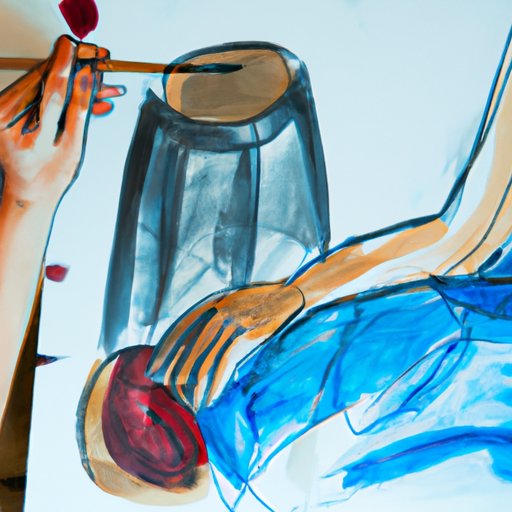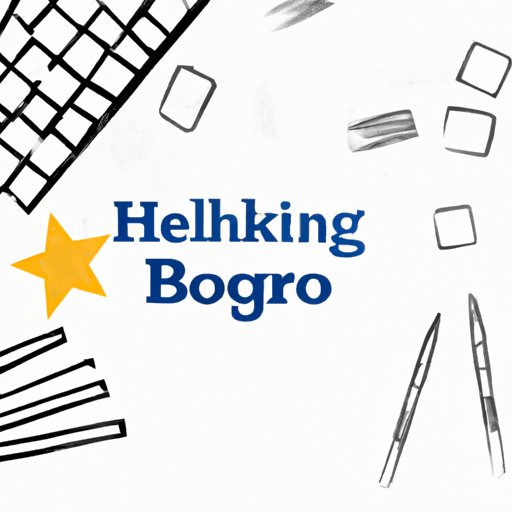
Introduction
Drawing is an art form that many people find both enjoyable and challenging. Whether you’re creating art for fun or as part of a professional practice, there are always opportunities to learn and improve your skills. However, mastering basic techniques and overcoming creative block can be daunting even for seasoned artists. In this article, we’ll explore tips and techniques for improving your drawing skills, no matter what your experience level is.
5 Simple Steps to Improve Your Drawing Skills
Improving your drawing skills starts with the basics. Here are five simple steps to get you started:
Step 1: Start with basic shapes and forms
Before you can create complex drawings, it’s important to master the building blocks of art. Practice drawing basic shapes and forms, including cubes, spheres, and cylinders. This will help you gain a better understanding of how different objects can be represented in two-dimensional space.
Step 2: Practice shading and creating contrast
Shading is an essential technique for creating depth and dimension in your drawings. Practice creating contrast by using different levels of shading and varying the amount of pressure you apply to your tools. By adding subtle variations in light and shadow, you can create more realistic and visually interesting drawings.
Step 3: Pay attention to proportions
Getting proportions right is crucial to creating realistic and accurate drawings. Pay attention to the size and shape of different objects and how they relate to one another. This will help you create drawings that look more realistic and achieve a better sense of balance and harmony.
Step 4: Utilize negative space
Negative space refers to the area around and between objects in a drawing. By paying attention to negative space and incorporating it into your work, you can create more interesting and dynamic compositions. Negative space can also help you better understand the relationships between different objects in your drawings.
Step 5: Incorporate details
Adding details is the final step in creating realistic and visually interesting drawings. While it’s important to focus on the big picture, details like texture, pattern, and lighting can add depth and complexity to your work. The key is to find a balance between including enough details to make your work visually interesting while not overdoing it.
The Importance of Gesture Drawing and How to Practice It
Gesture drawing is an important technique to improve your drawing abilities. It involves quickly sketching the basic movement and energy of a given subject, and it can help you develop a better understanding of the human form and how it interacts with space. Here are a few tips for practicing gesture drawing:
Define gesture drawing and how it can improve your drawing abilities
Gesture drawing is a process of quickly sketching the basic movement and energy of a subject to capture its essence. This technique can help artists develop a better understanding of the human form and how it interacts with the surrounding space, allowing them to create more dynamic and accurate drawings.
Discuss the basics of gesture drawing, including the importance of movement and energy in sketches
The key to gesture drawing is to quickly capture the movement and energy of a subject through loose, flowing lines. This technique allows you to capture the essence of a subject without getting bogged down in the details. By focusing on movement and energy, you can create drawings that feel more dynamic and realistic.
Offer tips on how to practice gesture drawing regularly and effectively
One way to practice gesture drawing is to set a timer for a short amount of time, such as one or two minutes, and sketch as quickly as you can. Another method is to take a series of photographs of a moving subject and practice sketching the movement and energy of the subject in quick, flowing lines. With practice, you can develop your own methods for practicing gesture drawing regularly and effectively.
From Stick Figures to Portraits: Tips for Progressing Your Drawing Skills
Whether you’re a beginner or an experienced artist, there’s always room to progress and improve your skills. Here are some tips for progressing your drawing skills:
Explain the importance of practicing and experimenting with different techniques in order to progress as an artist
It’s important to be open to new techniques and styles as you progress as an artist. This means experimenting with different drawing styles, mediums, and even subject matter to expand your skills and challenge yourself.
Offer tips for drawing basic shapes, including objects, environments, and human figures
When it comes to drawing objects, environments, and human figures, it’s important to break them down into basic shapes and forms to make the process less daunting. Practice drawing simple shapes and gradually work your way up to more complex subjects.
Discuss the importance of shading to create dimension and texture
Shading is a key technique for creating dimension and texture in your drawings. Experiment with different levels of shading to create the illusion of depth and texture, and don’t be afraid to try different shading techniques to achieve different effects.
Offer tips for adding details to take your drawings to the next level
Adding details is the final step in creating polished and visually interesting drawings. Consider the textures, patterns, and lighting in your subject matter, and try to incorporate those details into your work in a way that feels organic and natural.

Overcoming Creative Block: Techniques to Help You Get Back to Drawing
Creative block is a common issue that many artists face from time to time. Here are a few strategies for breaking through creative block:
Explain the concept of creative block and why many artists struggle with it
Creative block is a period of time when an artist is unable to create anything new or feels stuck in a particular style or technique. Many artists struggle with creative block at some point in their careers, and it can be frustrating and demotivating.
Offer strategies for breaking through creative block, including changing your environment, taking breaks, and getting feedback from peers
There are many strategies for breaking through creative block, including changing your environment, taking breaks to focus on other hobbies or activities, and seeking feedback from peers or mentors. Sometimes, simply shifting your focus can help you overcome creative block and find new inspiration.
Discuss the importance of setting goals and schedules to help you stay motivated
Setting goals and schedules can help you stay motivated and on track, even when you’re feeling creatively blocked. Consider setting realistic goals for yourself and breaking them down into smaller, manageable tasks to make it easier to stay on track and avoid feeling overwhelmed.
How to Draw Realistic Animals: Tips on Capturing Detail and Texture
Drawing realistic animals requires a solid understanding of animal anatomy and the ability to capture details like fur, feathers, and other textures. Here are a few tips for drawing realistic animals:
Discuss the basics of drawing animals, including understanding anatomy and body structure
To draw realistic animals, it’s important to understand basic animal anatomy and body structure. This can help you create drawings that are more accurate and visually compelling. Study animal anatomy books or online resources to gain a better understanding of the animals that you want to draw.
Offer tips on capturing details in fur, feathers, and other textures
Textures like fur, feathers, and other details help make animal drawings look more realistic. Pay attention to how light and shadows fall on different textures, and experiment with different shading techniques to create realistic and visually interesting textures.
Provide examples to illustrate the importance of observation and reference materials
Observation and reference materials are crucial when it comes to drawing realistic animals. Study photographs and videos of different animals in their natural habitats to gain a better understanding of their posture, movement, and anatomy. This will help you create more accurate and realistic drawings.
Exploring Different Mediums: Choosing the Right Tools for Your Drawing Project
There are many different mediums that artists can use to bring their drawings to life. Here’s a quick guide to help you choose the right tools for your drawing project:
Define different drawing mediums, including pencils, charcoal, and ink
There are many different drawing mediums available to artists, including graphite pencils, charcoal, ink, and more. Each medium has its own unique properties and is best suited for different types of projects and styles of drawing.
Discuss the importance of choosing the right tools based on your goals and the type of project you’re working on
When choosing drawing tools, it’s important to consider your goals and the type of project you’re working on. Some projects may require a certain level of detail, while others may focus more on texture and shading. Consider your goals and choose your tools accordingly.
Offer tips on experimenting with different mediums to find the ones that work best for you
Experimenting with different mediums can help you find the ones that work best for your style of drawing and the types of projects you enjoy. Try out different tools and techniques to find the ones that you enjoy and feel most comfortable using.
Conclusion
Improving your drawing skills takes time and practice, but it’s worth the effort. By mastering basic techniques, practicing regularly, and experimenting with different styles and mediums, you can continue to progress and evolve as an artist.




